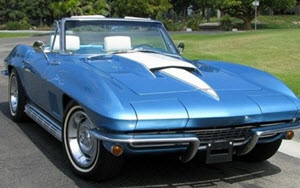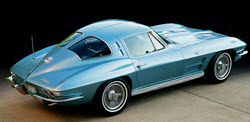1967 Corvette Sting Ray

The 1967 Corvette Sting Ray marks the end of the second generation Corvettes, the C2’s. These Corvettes, starting with the 1963 Corvette Sting Ray, are popularly referred to as the mid year Corvettes. 1967 was not only a special year for the Corvettes; it was special for all car makers since 1968 brought with it safety and smog legislation that effected important sports car markets.
The basic 1967 Corvette Sting Ray was equipped with a 327 cu. in. 300 hp engine, but when you purchased a 1967 Corvette Sting Ray, you could choose between several other engines for an additional fee. The most expensive alternative was the L88 427 cu. in. 430hp engine, which cost no less than $958. This was back in the days when an entire Base Corvette Convertible cost $4,240 and the coupe variant $4,388, so $958 was a considerably large sum of money. Two less expensive alternatives were the L71 427 cu. in. 435hp engine for $437 and the L68 427 cu. in. 400hp engine for $306. If you were satisfied with horsepowers below the 400s, you could opt for the $200 L36 427 cu. in. 390hp engine or have your 327 cu. in. engine boasted from 300 hp to 350hp for $105. Among the buyers that did not go for the standard 327 cu. in. 300 hp engine, the L79 327 cu. in. 350hp engine that cost no more than $105 was by far the most popular alternative and nearly 30 percent of the manufactured 1967 Corvette Sting Rays had his engine.

Earlier on, multiple carburettors had been used on the Pontiac GTO by General Motors and met with great success and much praise. A GM corporate ban had now caused them to be removed from the Pontiac, but the Corvette was exempted and multiple carburettors were used for both the L68 427 cu. in. 400hp engine and theL71 427 cu. in. 435hp engine. Three 2 bbl. Holly carburettors were placed on aluminium manifold; one in the front, one in the middle and one in the rear. During normal operation of the car, only the centre carb was utilized. This saved on fuel and made the Corvette less expensive to drive. When you reached 2000 RPM, the front and rear carburettors would kick in.
When it comes to the interior, there are a few notable changes between the 1966 Corvette Sting Ray and the 1967 model. The emergency brake had been moved to the centre consol (between the driver and the passenger), instead of being situated under the dashboard. In the 1967 Corvette Sting Ray, the emergency brake could therefore be accessed not only by the driver, but by the passenger as well. This was certainly not the only step towards increased safety. The steering column became extra energy absorbing and the rear view mirror was vinyl padded and shatter resistant. It also featured a break-away mount. The dash pad was extra thick and the knobs were mushroom shaped. If one of the dual circuit brake master cylinders failed in the 1967 Corvette Sting Ray, a warning light would immediately alert the driver. The new Corvette also had four way emergency flashers and a special “freeway lane change” function. Just as in previous versions of the Corvette you could pay extra to get headrests and shoulder belts ($42 and $26 respectively for the 1967 model). Many of the new Corvette additions would eventually be picked up by legislators and become mandatory in all cars.



